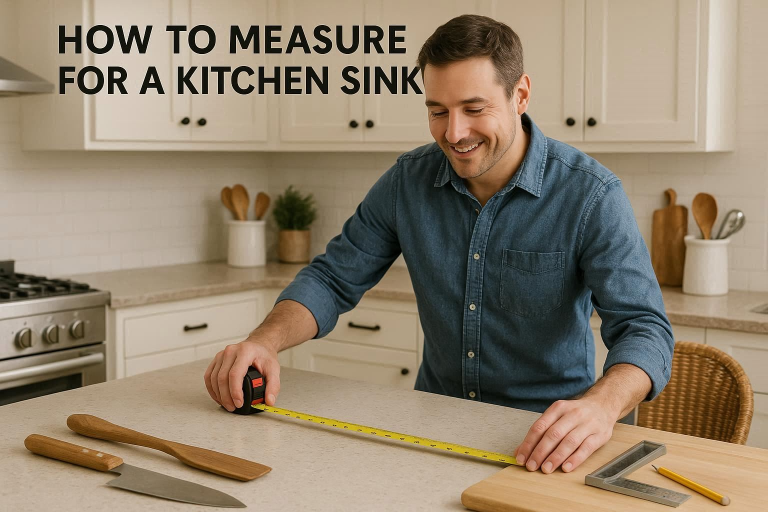When it comes to kitchen renovation or sink replacement, accurate measurements are crucial. Whether you’re installing a brand-new sink or replacing an old one, knowing how to measure properly ensures a perfect fit, saves you time, and prevents costly mistakes. A kitchen sink is not just a practical feature; it’s often a focal point of your kitchen, so getting the right size and style is important.
In this guide, we’ll walk you through the process of measuring for a kitchen sink, covering everything from choosing the right sink type to measuring the cutout size and sink depth. We’ll also discuss the different types of kitchen sinks, like drop-in and undermount, and their specific measurement requirements.
Why Accurate Measurements Matter for Your Kitchen Sink
Accurate measurements are essential for any sink installation or replacement project. Not only do they prevent the headaches of an ill-fitting sink, Cleaning Guide for Home & Kitchen but they also save you from unnecessary costs.
Avoiding Mistakes
Without precise measurements, your sink may not fit properly, leading to gaps, leaks, or unsightly installations. If you order the wrong size sink or cutout, it could mean delays and additional work to correct the mistake.
Cost and Time-Saving
By taking the time to measure carefully, you can avoid expensive rework and minimize the risk of having to purchase another sink. Proper measurements ensure that everything aligns with your existing plumbing and countertops, reducing installation time.
Types of Kitchen Sinks and Their Measurement Needs
Kitchen sinks come in various styles, and each type requires different measurements for installation:
- Drop-In Sinks: These sit on top of the countertop, with a lip around the edges. Drop-in sinks need accurate cabinet measurements and a cutout that matches the sink’s lip.
- Undermount Sinks: These are installed under the countertop, which means you need to measure the sink and the cutout carefully to ensure a proper fit and water seal.
- Farmhouse Sinks: These sinks have a front-facing apron and require specific cabinet adjustments to accommodate the apron style.
How to Measure for a Kitchen Sink Step by Step
Now, let’s dive into the steps you need to follow to measure for a kitchen sink, whether you’re installing a new one or replacing an old one.
Step 1: Determine the Type of Sink You Need
The first step is to decide which type of sink best suits your kitchen and how you use it. Consider these factors:
- Drop-In Sinks: Ideal for traditional kitchens. They are easier to install and have a visible lip around the edge.
- Undermount Sinks: Perfect for modern kitchens where a clean, seamless look is desired. These are mounted below the countertop.
- Farmhouse Sinks: Often a statement piece, these sinks feature a large, exposed front apron.
The type of sink will determine how you measure the cabinet space, sink cutout, and depth.
Step 2: Measure the Cabinet Size
To ensure your sink fits properly, you need to measure the cabinet space. Here’s how:
- Measure the Width: Measure the width of the cabinet opening. This will give you the maximum width of the sink.
- Measure the Depth: Measure the depth of the cabinet (from front to back). This ensures that the sink doesn’t interfere with any plumbing or other kitchen fixtures.
- Check for Obstructions: Ensure that there are no obstructions such as plumbing lines or supports that will interfere with the new sink.
Step 3: Measure the Sink Cutout Size
The next step is to measure for the sink cutout. The cutout is the space in your countertop where the sink will be installed. Here’s how to measure it:
- Measure the Sink: Measure the sink’s length, width, and depth. If you’re replacing an existing sink, make sure you measure the old sink, especially the lip for drop-in sinks.
- Account for Sink Lip: Drop-in sinks have a lip that sits over the countertop. The cutout must be smaller than the sink’s overall dimensions to accommodate the lip.
- Undermount Sink Cutout: For undermount sinks, the cutout must match the sink’s exact dimensions to ensure it fits properly under the countertop.
How to Measure a Drop-In Sink for Replacement
Replacing a drop-in sink requires taking careful measurements to ensure the new sink fits seamlessly into the existing space.
Step 1: Measure the Existing Sink
To replace your old drop-in sink:
- Length and Width: Measure the length and width of the existing sink from the outer edges. This will help determine the size of the new sink.
- Sink Lip: Take note of the lip that rests on the countertop. This is important when measuring the cutout size. The cutout needs to be slightly smaller than the sink’s outer edge.
Step 2: Measure the Cabinet Opening
Measure the dimensions of the cabinet beneath the sink:
- Width and Depth: These dimensions will determine whether your new sink will fit comfortably inside the cabinet.
- Check for Obstructions: Be sure there are no pipes, drainage, or support beams that could interfere with the new sink.
Step 3: Account for Drain and Faucet Placement
You must also account for the plumbing:
- Drain and Faucet Placement: Ensure the sink’s drain holes align with the plumbing, and measure the distance from the edge of the sink to the faucet and garbage disposal. These measurements are crucial to avoid installation problems.
Kitchen Sink Standard Size
When it comes to standard kitchen sink sizes, there are a few common options, but you can always find custom options as well.
Standard Kitchen Sink Sizes in Inches
Common kitchen sink sizes in inches include:
- 22 x 30 inches: A standard size that works well for most kitchen spaces.
- 25 x 22 inches: Another popular option, especially in smaller kitchens.
- 33 x 22 inches: A larger sink, great for families or those who do a lot of cooking.
Standard Kitchen Sink Dimensions in cm
If you need to convert these measurements to centimeters:
- 22 x 30 inches = 55.88 x 76.2 cm
- 25 x 22 inches = 63.5 x 55.88 cm
- 33 x 22 inches = 83.82 x 55.88 cm
How to Measure Kitchen Sink Depth
Sink depth plays a huge role in functionality. It determines how much you can fit inside the sink and how comfortable it is to use.
Measuring Depth for Drop-In and Undermount Sinks
- From Rim to Basin: Measure from the edge (rim) of the sink to the bottom of the basin. This will give you the depth of the sink.
- Sink Type Differences: Drop-in sinks typically have a shallower depth compared to undermount sinks, which can vary in depth more significantly.
Ideal Sink Depth for Different Uses
- Deep Sinks: These are great for large pots and pans, as well as cleaning large items. Depths of around 10–12 inches are ideal for those who do heavy cooking.
- Shallow Sinks: Best for quick washing tasks, such as rinsing dishes or fruits. These sinks tend to have a depth of 7–9 inches.
The Effect of Depth on Ergonomics
Deep sinks may require more bending, which could be uncomfortable for some. If ergonomics are important to you, consider a sink depth that allows for comfortable use without straining.
Kitchen Sink Sizes in Inches
Here are some common kitchen sink sizes in inches and their typical uses:
- 24 x 18 inches: Ideal for compact kitchens or small apartments.
- 33 x 22 inches: Standard size for most kitchens.
- 25 x 22 inches: A good middle ground for medium-sized kitchens.
Choosing the Right Sink Size Based on Space
When selecting your kitchen sink size, consider your kitchen layout. A larger sink is perfect for spacious kitchens or family homes, while a smaller sink may be more appropriate for cramped spaces.
How to Measure a Kitchen Sink for Replacement (Undermount)
Undermount sinks require precise measurements because they are installed beneath the countertop.
Step 1: Remove the Old Sink
To remove your existing undermount sink, take precautions to avoid damaging your countertop. Be sure to disconnect the plumbing before removal.
Step 2: Measure the Sink and Cutout Size
- Measure the Sink: Measure the length, width, and depth of the existing undermount sink.
- Cutout Size: For the new sink, the cutout should match the sink’s dimensions exactly, leaving a slight gap between the sink and countertop for sealing.
Step 3: Account for Plumbing and Fixtures
Ensure the new sink will align with the existing plumbing, faucet, and garbage disposal. Measure the distance between these components to avoid any installation issues.
Standard Kitchen Sink Cutout Size
The cutout is the space in your countertop that allows the sink to sit properly. Different sink types require different cutout sizes.
What is a Sink Cutout and Why is it Important?
The cutout must be slightly smaller than the sink’s outer dimensions for drop-in sinks, while it must match the exact size of the sink for undermount installations.
How to Measure the Cutout
- Measure the Sink Lip: For drop-in sinks, measure the lip and ensure the cutout is slightly smaller than the sink’s overall width and length.
- Undermount Sinks: The cutout for an undermount sink should match the sink’s size exactly.
How to Measure for a Kitchen Sink in Inches
Measuring in inches is important for consistency, especially when ordering a pre-made sink.
Step-by-Step Guide to Measuring in Inches
Measure the length, width, and depth of your sink space in inches, then compare these dimensions to the standard sink sizes. If needed, convert to centimeters for international use.
Additional Considerations When Measuring for a Kitchen Sink
Sink Installation Method: Drop-In vs. Undermount
The installation method affects how you measure the cutout size, as well as the cabinet space needed. Drop-in sinks require a lip around the sink, while undermount sinks need a precise cutout beneath the countertop.
Countertop Material Considerations
Consider the type of countertop you have, whether it’s granite, quartz, or another material. Some materials may require special tools for cutting the sink opening.
Future-Proofing Your Sink Size
Choosing a slightly larger sink than necessary can give you more flexibility in the future, especially if your kitchen layout changes.
FAQ
What is the standard kitchen sink size?
Standard kitchen sinks usually come in sizes such as 22 x 30 inches, 25 x 22 inches, and 33 x 22 inches.
How do I measure a kitchen sink for replacement?
Measure the length, width, and depth of your current sink and ensure the cabinet and cutout sizes match your new sink.
What is the standard size for a kitchen sink cutout?
For drop-in sinks, the cutout is usually slightly smaller than the sink’s overall dimensions, while for undermount sinks, the cutout must match the sink exactly.
How deep should my kitchen sink be?
Sinks range from 7 to 12 inches in depth, with deeper sinks ideal for larger pots and shallow sinks better for quick tasks.
Can I replace my kitchen sink without changing the countertop?
Yes, as long as the new sink fits the existing cutout and plumbing aligns.
What if my sink is too big for my cabinet?
Consider custom or adjustable cabinets or choose a smaller sink to ensure it fits.
Conclusion
Measuring for a kitchen sink is an essential step for a successful installation or replacement project. By following these steps and taking your time, you can avoid costly mistakes and enjoy a sink that fits perfectly in your kitchen. Be sure to measure twice and choose a sink that fits both your space and your needs. Happy renovating!

